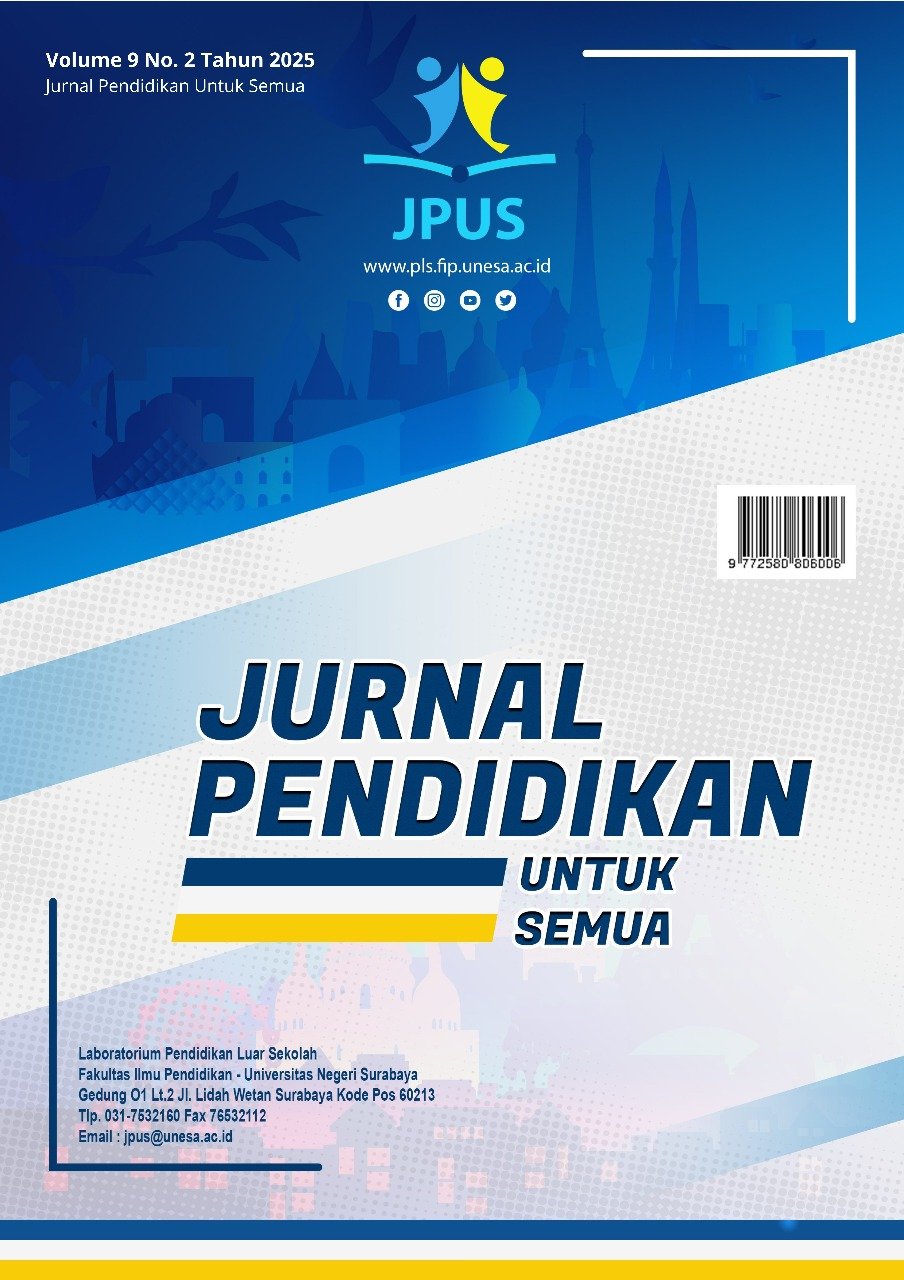Pemberdayaan Melalui Pengembangan Soft Skill Kewirausahaan Untuk Kemandirian Bagi Siswa Dewasa di Pusat Kegiatan Belajar Masyarakat Kinabalu Malaysia
DOI:
https://doi.org/10.26740/jpus.v9n2.p34-40Keywords:
soft skill kewirausahaan, , pendidikan orang dewasa, kemandirian ekonomi, pekerja migranAbstract
This study aims to explore the process of developing entrepreneurial soft skills as a strategy to increase the economic independence of adult students at the Community Learning Center (CLC) Kinabalu, Malaysia. The background of this study is limited access to formal education, low non-technical skills, and minimal entrepreneurial awareness among Package C students from families of Indonesian Migrant Workers (PMI). The study used a qualitative approach with an intrinsic case study design. Data were collected through in-depth interviews, participant observation during training, and document analysis. The intervention process was carried out online for four days with reference to the Asset-Based Community Development (ABCD) approach and andragogy principles. Data analysis was carried out using thematic analysis techniques to identify patterns of strengthening soft skills competencies including effective communication, adaptive leadership, creative problem solving, self- and time management, adaptation to change, emotional intelligence, results orientation, and networking. The results of the study revealed three main themes: (1) internalization of entrepreneurial values through experiential learning, (2) transformation of self-confidence into courage to start small businesses based on local resources, and (3) utilization of digital media as a means of developing business networks. This study concludes that strengthening local asset-based soft skills can shape entrepreneurial readiness in adult migrant communities, while also being a model that can be replicated in the context of non-formal education in border areas or other vulnerable communities.
References
Akadira, T. (2024). Financial Capacity of Indonesian Schools and Community Learning Centers in Kota Kinabalu: A Comparative Analysis. AL-ISHLAH: Jurnal Pendidikan, 16(3). https://doi.org/10.35445/alishlah.v16i3.5599
Alamri, A. R., Nurwati, R. N., Rusyidi, B., & Hermanto, B. (2024). Asset-based Community Development (ABCD): in Conversation with John McKnight about the Heritage of ABCD and its Place in the World Today (3rd edition). Community Development Journal, 60(3), 606–609. https://doi.org/10.1093/cdj/bsae064
Alamri, H., Watson, S., & Watson, W. (2021). Learning Technology Models that Support Personalization within Blended Learning Environments in Higher Education. TechTrends, 65(1), 62–78. https://doi.org/10.1007/s11528-020-00530-3
Braun, V., & Clarke, V. (2006). Using thematic analysis in psychology. Qualitative Research in Psychology, 3(2), 77–101. https://doi.org/10.1191/1478088706qp063oa
Chowdhury, S., Ahmmed, F., & Hossain, Md. I. (2020). Methodological Dilemma in Microfinance Research: Applicability of a Qualitative Case Study Design. The Qualitative Report. https://doi.org/10.46743/2160-3715/2020.3962
Crowe, S., Cresswell, K., Robertson, A., Huby, G., Avery, A., & Sheikh, A. (2011). The case study approach. BMC Medical Research Methodology, 11(1). https://doi.org/10.1186/1471-2288-11-100
Knowles, M. S., Holton, E. F., & Swanson, R. A. (2015). The Adult Learner: The Definitive Classic in Adult Education and Human Resource Development (8, Ed.). Routledge.
Llopis, M. P., Senft, R. A., Ross-Elliott, T. J., Stephansky, R., Keeley, D. P., Koshar, P., Marqués, G., Gao, Y.-S., Carlson, B. R., Pengo, T., Sanders, M. A., Cameron, L. A., & Itano, M. S. (2021). Best practices and tools for reporting reproducible fluorescence microscopy methods. Nature Methods, 18(12), 1463–1476. https://doi.org/10.1038/s41592-021-01156-w
Miller, E., Porter, J., & Barbagallo, M. (2022). Simplifying Qualitative Case Study Research Methodology: A Step-By-Step Guide Using a Palliative Care Example. The Qualitative Report. https://doi.org/10.46743/2160-3715/2023.6478
Pellissery, S., Mathew, B., Govindjee, A., & Narrain, A. (2019). Transformative Law and Public Policy. Routledge India. https://doi.org/10.4324/9780429344657
Purnomo, P., Hufad, A., Sutarni, N., & Mutaman, M. H. A. (2024). Technology-Based Education Marketplace Software for Adult Learning. Journal of Advanced Research in Applied Sciences and Engineering Technology, 85–100. https://doi.org/10.37934/araset.62.2.85100
Rahma, R. A., Zulkarnain, Desyanty, E. S., & Wahyuni, S. (2019). The Role of Community Learning Center (CLC) in Providing Nonformal Education Services Based on Entrepreneurship. 5. https://doi.org/10.15294/jne.v5i2.19759
Rashid, Y., Rashid, A., Warraich, M. A., Sabir, S. S., & Waseem, A. (2019). Case Study Method: A Step-by-Step Guide for Business Researchers. International Journal of Qualitative Methods, 18. https://doi.org/10.1177/1609406919862424
Robles, M. M. (2012). Executive Perceptions of the Top 10 Soft Skills Needed in Today’s Workplace. Business Communication Quarterly, 75(4), 453–465. https://doi.org/10.1177/1080569912460400
Sholih, S., & Assat, D. L. (2017). Independence Citizens Learning Model Through Community Entrepreneurship Management Education in Banten Province. Proceedings of the 3rd NFE Conference on Lifelong Learning (NFE 2016). https://doi.org/10.2991/nfe-16.2017.50
Sugarman, L. (1987). Experiential learning: Experience as the source of learning and development, David A. Kolb, Prentice‐Hall International, Hemel Hempstead, Herts., 1984. No. of pages: xiii + 256. Journal of Organizational Behavior, 8(4), 359–360. https://doi.org/10.1002/job.4030080408
Widodo, W., Atmaja, I. K., Siswanto, H., Firmansyah, A., & Yusuf, A. (2024). Entrepreneurship-Based Non-Formal Education Program Development Through Coaching Clinic. Journal of Nonformal Education, 10(1), 1–9. https://doi.org/10.15294/jone.v10i1.1587
Downloads
Published
Issue
Section
License
Copyright (c) 2025 heryanto susilo, widodo, I ketut atmaja johny artha, mustakim, m fahmi zakariyah

This work is licensed under a Creative Commons Attribution-NonCommercial-ShareAlike 4.0 International License.

 Abstract views: 57
,
Abstract views: 57
, PDF Downloads: 54
PDF Downloads: 54






